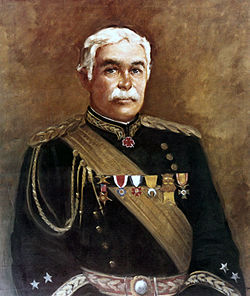Samuel Baldwin Marks Young
| Samuel Baldwin Marks Young | |
|---|---|

General Samuel B. M. Young, official portrait by Marion Potter Sharpe
|
|
| Born |
January 9, 1840 Pittsburgh, Pennsylvania |
| Died | September 1, 1924 (aged 84) Helena, Montana |
| Place of burial | Arlington National Cemetery |
| Allegiance |
United States of America Union |
| Service/branch |
United States Army Union Army |
| Years of service | 1861–1865, 1866–1904 |
| Rank |
|
| Commands held | Chief of Staff of the United States Army |
| Battles/wars | American Civil War |
Samuel Baldwin Marks Young (January 9, 1840 – September 1, 1924) was a United States Army general. He also served as the first president of Army War College between 1902 and 1903. He then served from 1903 until 1904 as the first Chief of Staff of the United States Army.
Young was born in Pittsburgh, Pennsylvania, to John Young Jr. and Hannah Scott Young. He was educated at Jefferson College (now Washington & Jefferson College) and married Margaret McFadden in 1861.
On the outbreak of the Civil War, he joined the 12th Pennsylvania Infantry in April 1861 as a private. After the expiration of his term he was commissioned captain, 4th Pennsylvania Cavalry in September. He served with distinction in the Army of the Potomac throughout the war, receiving promotion to major in September 1862, to lieutenant colonel in October 1864 and to colonel in December 1864. Young was wounded four times in 1864 and 1865. He served in brigade command in the cavalry corps during the last days of the Appomattox Campaign. He was mustered out of the volunteers on July 1, 1865.
After the war, Young joined the Military Order of the Loyal Legion of the United States - a military society for officers who had served the Union in the Civil War. He was also a member of the Society of the Army of the Potomac.
After the Civil War he rejoined the Regular Army as a first lieutenant in May 1866, and was promoted to captain of the 8th U.S. Cavalry in July 1866. On December 11, 1866, President Andrew Johnson nominated Young for appointment to the brevet rank of brigadier general of volunteers, to rank from April 9, 1865, in recognition for his services in the Siege of Petersburg and the Appomattox Campaign and the U.S. Senate confirmed the appointment on February 6, 1867.
...
Wikipedia
